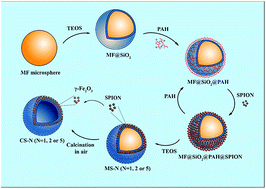Thermo-stable hollow magnetic microspheres: preparation, characterization and recyclable catalytic applications†
Abstract
Thermo-stable hollow magnetic microspheres are prepared by layer-by-layer (LbL) assembly on a uniform melamine–formaldehyde resin microsphere template coated by silica and calcination for burning off organic resin. Trypsin is immobilized by their coated polydopamine layer, and nanogold particles are assembled onto the microspheres by the LbL method for catalytic applications. The morphologies and hollow structures are observed by using a scanning electron microscope and transmission electron microscope. The characteristics are investigated by Fourier transfer infrared spectroscopy, thermo-gravimetric analysis and vibrating sample magnetometry. Meanwhile, the catalytic characteristics of nanogold particles and trypsin are evaluated by ultraviolet-visible spectra. The prepared hollow thermo-stable magnetic microspheres are narrow-dispersed with a relatively low coefficient of variation, and their size ranging from 0.5 μm to 5.0 μm and saturation magnetization (4–30 emu g−1) can be regulated by different conditions. Combined with magnetic separation and calcination activation or regeneration, these microspheres can also be reused over 20 times for nanogold catalyst and over 32 times for trypsin catalyst reconjugation without any significant loss in catalytic activity, indicating their considerable potential for recyclable catalytic applications.


 Please wait while we load your content...
Please wait while we load your content...